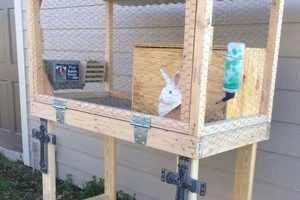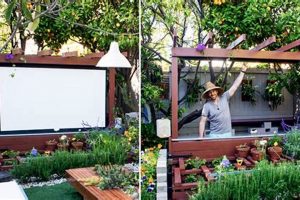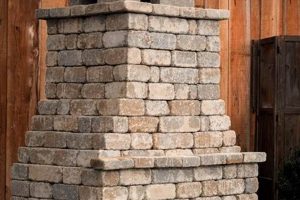Fabric barriers designed for exterior use, often created by individuals rather than purchased pre-made, offer shading, privacy, and aesthetic enhancements to outdoor living spaces. These textile installations serve as adjustable screens against sunlight, wind, and prying eyes, and can also contribute to the overall dcor of patios, porches, and decks.
The utilization of these custom-made shade solutions presents several advantages. Cost savings are a primary motivator, as crafting them can be more economical than purchasing commercially produced alternatives. Furthermore, constructing these barriers allows for complete customization in terms of fabric choice, size, and design, ensuring a seamless integration with existing outdoor furniture and architectural features. Historically, using textiles for outdoor shading dates back to ancient civilizations, where draped fabrics provided relief from harsh weather conditions.
The subsequent sections will detail practical considerations for constructing these functional outdoor accessories, including material selection, essential tools, construction techniques, and installation methods, providing a comprehensive guide for creating customized outdoor privacy and shade solutions.
Essential Considerations for Fabricating Exterior Textile Screens
The construction of weather-resistant fabric screens for outdoor spaces necessitates careful planning and execution. Adherence to the following guidelines will enhance both the longevity and functionality of the finished product.
Tip 1: Fabric Selection is Paramount: Opt for textiles specifically engineered for outdoor use. These materials exhibit enhanced resistance to fading, moisture, and mildew. Examples include solution-dyed acrylics, outdoor polyester blends, and treated canvas.
Tip 2: Reinforce Stress Points: Areas where the fabric is attached to hardware, such as grommets or loops, are particularly vulnerable to tearing. Reinforce these points with additional layers of fabric or specialized webbing.
Tip 3: Account for Environmental Factors: Consider prevailing wind conditions when determining the overall dimensions and anchoring methods. Larger spans of fabric require more robust support structures and secure attachment points.
Tip 4: Incorporate Drainage: Fabric can pool water during rainfall. Design elements such as spaced grommets or a slight slope in the fabric can facilitate water runoff and prevent sagging.
Tip 5: Select Appropriate Hardware: Use rust-resistant hardware suitable for outdoor environments. Stainless steel, aluminum, or powder-coated metal components will withstand exposure to moisture and prevent corrosion.
Tip 6: Implement Secure Attachment Methods: The means by which the fabric is attached to the support structure significantly impacts its stability. Consider using robust hooks, clips, or tie-downs designed for outdoor use.
Tip 7: Plan for Maintenance: Regular cleaning will prolong the lifespan of the fabric. Select materials that are easily cleaned with soap and water. Consider applying a fabric protector to enhance stain resistance.
By focusing on durable materials, reinforced construction, and weather-resistant hardware, the resulting textile screens will provide years of reliable service and enhance the aesthetic appeal of outdoor living spaces.
The subsequent section provides a step-by-step methodology for the construction process.
1. Fabric Weather Resistance
The longevity and efficacy of fabric-based outdoor barriers are directly contingent upon the material’s inherent resistance to environmental elements. Solar radiation, precipitation, temperature fluctuations, and wind exert constant stresses on outdoor textiles. Inadequate resistance to these factors results in premature degradation, discoloration, and structural failure, negating the intended function of shading or privacy provision. For instance, cotton canvas, while initially affordable, will rapidly fade, weaken, and become susceptible to mold and mildew in humid environments, rendering it unsuitable for prolonged outdoor use.
Solution-dyed acrylic fabrics, designed explicitly for outdoor applications, exemplify effective weather resistance. The dyeing process permeates the fiber itself, thereby imbuing superior fade resistance compared to surface-dyed materials. Additionally, these fabrics often incorporate water-repellent finishes and antimicrobial treatments, mitigating moisture absorption and preventing microbial growth. This resistance not only preserves the fabric’s aesthetic qualities but also maintains its structural integrity, ensuring long-term performance under varying weather conditions.
The specification of weather-resistant fabrics for the construction of exterior textile installations is, therefore, not merely a cosmetic consideration, but a critical determinant of their functional lifespan. The initial investment in high-performance materials yields significant long-term cost savings by reducing the frequency of replacements and minimizing maintenance requirements. Moreover, by resisting degradation, such materials contribute to environmental sustainability, mitigating the need for frequent resource consumption. Fabric weather resistance is not just a material characteristic; it is a core component of durable and cost-effective outdoor shade solutions.
2. Hardware Durability
The structural integrity and operational longevity of fabric barriers designed for outdoor environments are inextricably linked to the durability of the hardware employed in their construction and installation. Compromised hardware undermines the stability of the textile component, leading to premature failure, potential safety hazards, and diminished aesthetic appeal.
- Material Composition and Corrosion Resistance
The selection of materials resistant to corrosion is paramount. Stainless steel, aluminum, and powder-coated metals are commonly utilized for their ability to withstand prolonged exposure to moisture, salt, and other corrosive elements. Substituting these with inferior materials, such as untreated steel, invariably leads to rust formation, weakening the hardware and potentially staining the fabric.
- Load-Bearing Capacity and Structural Integrity
Hardware must be rated to withstand the anticipated load imposed by the fabric, wind, and other environmental factors. Undersized brackets, hooks, or cables will exhibit excessive stress, resulting in bending, breakage, or detachment. Proper load calculations and the selection of appropriately rated hardware are essential for ensuring structural integrity.
- Fastener Security and Resistance to Loosening
The fasteners used to secure the hardware to the supporting structure, such as screws, bolts, and anchors, must possess adequate strength and resistance to loosening. Vibrations induced by wind and other environmental factors can gradually loosen improperly secured fasteners, compromising the stability of the entire installation. Locking mechanisms or thread-locking compounds can mitigate this risk.
- UV Degradation of Non-Metallic Components
Certain non-metallic components, such as plastic clips or ropes, are susceptible to degradation from prolonged exposure to ultraviolet (UV) radiation. This degradation can lead to embrittlement and failure, rendering the hardware ineffective. Specifying UV-resistant materials or providing shielding from direct sunlight can prolong the lifespan of these components.
In summation, the specification of durable, corrosion-resistant hardware is a critical determinant of the performance and longevity of fabric barriers designed for outdoor environments. A commitment to selecting high-quality components ensures structural stability, minimizes maintenance requirements, and enhances the overall aesthetic appeal of the installation, maximizing the return on investment.
3. Installation Security
The success and safety of fabric barriers created for exterior use depend significantly on the robustness of their installation. Secure installation methods are not merely a matter of aesthetic preference but are fundamentally linked to the structural integrity and longevity of the installation, mitigating potential hazards arising from detachment or collapse. Inadequate installation techniques increase the risk of the structure failing under normal environmental stresses, such as wind loads or accumulated precipitation, potentially causing damage to property or injury to individuals.
Consider, for example, an instance where insufficient anchoring is employed for a large fabric shade sail. A sudden gust of wind could exert excessive force on the inadequately secured attachment points, leading to their failure. This failure could result in the entire fabric structure tearing free, posing a risk of impact to nearby objects or individuals. Conversely, a well-executed installation incorporates appropriately sized and rated hardware, secure anchoring methods, and consideration of local wind conditions, thereby minimizing the risk of such an occurrence. The selection of appropriate fasteners, such as lag screws or concrete anchors, based on the substrate material, directly influences the holding power and overall stability of the fabric screen. Furthermore, proper tensioning of the fabric during installation ensures that the load is evenly distributed across the support structure, preventing localized stress concentrations that could lead to failure.
In summary, the security of the installation is a critical factor in the successful and safe utilization of diy outdoor curtains. Attention to detail in selecting appropriate hardware, employing secure anchoring methods, and accounting for environmental loads are essential for ensuring the long-term stability and safety of the installation. The initial investment in proper installation techniques translates to reduced maintenance costs, minimized risk of damage or injury, and enhanced peace of mind regarding the reliability of the outdoor space.
4. Design Customization
The inherent adaptability of self-constructed exterior fabric screens, versus pre-fabricated alternatives, places a strong emphasis on design customization as a core component. This level of personalization allows for a seamless integration with the existing architectural and landscaping elements of a given outdoor space, enhancing both its functionality and aesthetic appeal.
- Fabric Pattern and Color Selection
The choice of fabric pattern and color is a primary avenue for personalization. Individuals can select materials that complement existing outdoor furniture, architectural finishes, or even the surrounding landscape. For instance, a homeowner might opt for a striped fabric in nautical colors for a coastal-themed deck, or a solid-colored, neutral fabric to blend seamlessly with a minimalist patio design. This selection significantly impacts the visual impact of the fabric screen, contributing to the overall ambiance of the outdoor space.
- Dimensional Tailoring for Specific Spaces
Unlike standardized pre-made products, self-constructed fabric screens can be precisely tailored to fit the unique dimensions of a given area. This allows for optimal coverage and shading, maximizing functionality. For example, an irregularly shaped porch can be effectively screened with custom-cut fabric panels, ensuring complete privacy and protection from the elements. This level of dimensional control is often unattainable with off-the-shelf solutions.
- Hardware and Mounting Adaptability
Design customization extends to the selection and placement of hardware and mounting mechanisms. Individuals can choose hardware finishes that complement existing outdoor fixtures, or adapt the mounting system to accommodate specific architectural features, such as overhanging eaves or existing support posts. This level of adaptability ensures a cohesive and aesthetically pleasing integration of the fabric screen within the overall outdoor environment.
- Incorporation of Functional Elements
Design customization enables the integration of functional elements that enhance the utility of the fabric screen. This might include the addition of pockets for storing small items, tie-backs for controlling light and airflow, or even integrated insect netting for added protection. These functional enhancements contribute to the overall practicality and user-friendliness of the self-constructed exterior fabric screen.
These distinct facets of design customization ultimately converge to create exterior fabric screens that are not only functional and durable but also reflect the unique aesthetic preferences of the individual. This level of personalization significantly enhances the value and enjoyment derived from outdoor living spaces, transforming them into inviting and comfortable extensions of the home.
5. Maintenance Accessibility
The operational lifespan and sustained aesthetic appeal of fabric barriers intended for outdoor use are fundamentally linked to the ease with which they can be maintained. Constructing these barriers with accessibility for cleaning, repairs, and seasonal adjustments in mind is not merely a convenience but a critical factor determining their long-term performance and cost-effectiveness. Inadequate planning for maintenance accessibility can lead to accelerated degradation, increased repair frequency, and ultimately, the premature replacement of the entire installation.
For instance, consider a fabric shade structure installed over a patio where the fabric panels are permanently affixed to the supporting framework. Over time, the accumulation of dirt, mildew, and atmospheric pollutants will inevitably diminish the fabric’s appearance and structural integrity. However, if the panels are difficult to remove for cleaning or repair, due to complex or inaccessible attachment mechanisms, the homeowner may be compelled to delay or forgo necessary maintenance tasks. This neglect can exacerbate the rate of deterioration, leading to irreversible damage and necessitating costly replacements. Conversely, a design incorporating easily detachable fabric panels, utilizing simple hooks, clips, or slide-on tracks, facilitates regular cleaning, allows for prompt repairs to minor tears or damage, and enables the seasonal removal of the fabric for winter storage, significantly extending its lifespan.
Ultimately, incorporating maintenance accessibility into the design and construction of exterior fabric screens represents a prudent investment in their long-term viability. By prioritizing ease of access for cleaning, repairs, and seasonal adjustments, individuals can minimize maintenance costs, prolong the functional lifespan of the installation, and maintain its aesthetic appeal, ensuring enduring value and enjoyment of the outdoor space. This proactive approach to maintenance accessibility is thus an essential element in achieving a successful and sustainable outdoor living environment.
Frequently Asked Questions
The following section addresses common inquiries and misconceptions regarding the design, construction, and maintenance of self-made textile screens for outdoor environments. The information provided is intended to offer clarity and guidance for individuals undertaking such projects.
Question 1: What fabric types are most suitable for exterior applications, considering weather resistance and durability?
Fabrics engineered specifically for outdoor use are recommended. Solution-dyed acrylics exhibit superior fade resistance and water repellency. Outdoor polyester blends offer durability and ease of cleaning. Canvas, while affordable, requires treatment for water resistance and mildew prevention. Natural fibers such as cotton are generally unsuitable due to their susceptibility to degradation.
Question 2: What hardware is recommended for securing fabric screens, and what factors should be considered for optimal stability?
Rust-resistant hardware, such as stainless steel or powder-coated metal, is essential. Consider load-bearing capacity, wind resistance, and fastener security. Grommets should be reinforced. Mounting brackets must be appropriately sized for the weight and dimensions of the fabric panel. Anchors suitable for the supporting structure are critical for preventing detachment.
Question 3: How should the design of fabric barriers account for potential water accumulation during rainfall?
Incorporating drainage mechanisms is crucial. Spaced grommets or strategically placed drainage holes facilitate water runoff. A slight slope in the fabric can also prevent water from pooling. Water-resistant or water-repellent fabric treatments minimize water absorption and reduce the overall weight load.
Question 4: What are the recommended cleaning and maintenance procedures for prolonging the lifespan of exterior textile installations?
Regular cleaning with mild soap and water is essential. Remove debris and stains promptly. Consider applying a fabric protector to enhance stain resistance. Seasonal removal and storage during inclement weather can significantly extend the lifespan of the fabric.
Question 5: How can the safety of fabric screens be ensured, particularly in high-wind conditions?
Secure anchoring is paramount. Employ appropriately sized fasteners and ensure they are securely attached to the supporting structure. Consider the prevailing wind conditions when determining the overall dimensions of the fabric panel. Reinforce stress points and employ robust attachment mechanisms to prevent tearing or detachment.
Question 6: What design considerations should be taken into account to ensure both functionality and aesthetic appeal of the fabric screens?
Select fabric patterns and colors that complement the existing outdoor environment. Tailor the dimensions of the fabric panels to fit the specific space. Choose hardware finishes that blend seamlessly with the surrounding fixtures. Consider incorporating functional elements, such as tie-backs or pockets, to enhance utility.
In summary, careful material selection, robust hardware implementation, secure installation practices, and diligent maintenance are all essential to ensuring the longevity, safety, and aesthetic appeal of self-constructed exterior fabric screens.
The subsequent section provides a comprehensive list of the tools and materials required to complete the construction.
Conclusion
The preceding discussion has explored the multifaceted aspects of diy outdoor curtains, emphasizing the critical role of material selection, hardware durability, secure installation, customizable design, and accessible maintenance. Adherence to these principles ensures the creation of functional, durable, and aesthetically pleasing exterior textile solutions.
The information presented provides a foundation for individuals seeking to enhance outdoor living spaces through custom-built fabric barriers. The careful consideration of these factors will contribute to a successful project, maximizing the benefits of privacy, shade, and visual appeal while minimizing the risks of premature failure or safety hazards. Further research into specific material properties and installation techniques is encouraged for optimal results.







